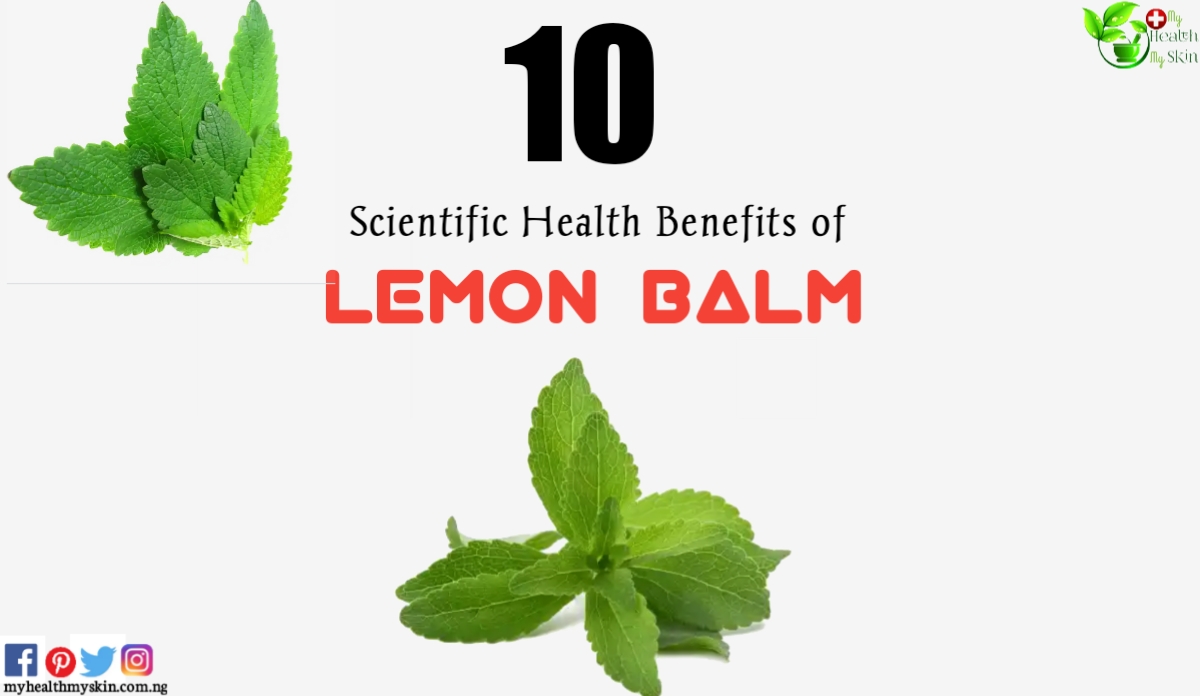Like many herbs, lemon balm (Melissa officinalis) has a long history of use in traditional medicine. This aromatic herb is primarily propagated from seed, stem cutting and root divisions in Middle East and North Africa, and aside from having a bright subtly sweet flavor and a citrusy taste, lemon balm is also known to promote sleep, reduce stress and anxiety, ease pain and discomfort from indigestion, and improve appetite, according to a past review.
The primary active component of Lemon balm: and the one that gives the herb its flavor and aromatic (mint) characteristic: is citral and citronellal.
Although other phytochemicals, including geraniol (which is rose-scented) and linalool (which is lavender-scented), also contribute to lemon balm’s scent.
In fact, these are some of the phytochemical compounds responsible for most of lemon balm potential health benefits. Other phytochemicals in lemon balm which may provide antioxidant activity include phenolic acids, terpenes, rosmarinic acid and caffeic acids.
[lwptoc]
“Lemon is high in flavonoids which is a natural antioxidant, and can be effective as well. Lemon B grows well in mild temperate climates between the months of June and August. It is also known as: Bee balm, Cure-All, Dropsy plant, Honey plant, Sweet balm, Sweet Mary, Toronjil, Xiang Feng Cao (in traditional Chinese medicine).
What Are the Science-Backed Health Benefits of Lemon Balm?
As said earlier, lemon Balm is use to ease stress and anxiety, it contains a compound known as rosmarinic acid that appears to have potent anti-oxidant and anti-microbial properties.
Alternative health care practitioners believe that lemon B can be used in treating a wide range of health problems, including: insomnia, cold sores, high cholesterol, genital herpes, heartburn, and indigestion.
Also, there are some who even contend that it can improve cognitive function in people with Alzheimer’s disease.
Here, we outline some lemon balm health benefits:
1. Anxiety
Lemon balm may help reduce symptoms of anxiety, such as sweating and hyperventilation. A 2014 study Trusted Source examined the mood and cognitive effects of foods containing lemon balm.
The supplement was mixed into a beverage and into yogurt along with either natural or artificial sweeteners.
Participants in both groups reported positive effects on several aspects of mood, including reduced levels of anxiety. Although this is promising, more research is needed to truly determine its efficacy.
2. Stress
Lemon balm is said to soothe symptoms of stress, boosting your mood and also helps in relaxation.
Research published in 2004 found that taking lemon balm eased the negative mood impacts of laboratory-induced psychological stress. Participants who took lemon balm self-reported an high sense of calmness and low feelings of alertness.
Although this was a double-blind, placebo-controlled study, it had a small sample size of about 18 people. Further research is needed to explain these findings.
3. Cognitive Function
The same Research published in 2014 also looked at the effects of lemon balm in boosting cognitive function.
Participants were asked to do cognitive test involving memory, mathematics, and concentration. The outcome of these computerized tests suggest that participants who ingested lemon balm performed better than those who didn’t.
Although these participants did experience an increase in levels of alertness and performance, it’s still possible for fatigue to set in over time.
The Combination of lemon balm with food also affects its absorption rate, which may have had an impact on its efficacy. Further studies are needed to expand on these findings.
4. Ease Insomnia And Other Sleep Disorders
The Combination of lemon balm with valerian may help relieve restlessness and sleep disorders such as Insomnia, Narcolepsy, Sleep Apnea.
A 2006 study Trusted Source found that children who took a combined dose experienced a 70 to 80 percent improvement in symptoms. Both the researchers and parents regarded lemon balm as being a good medication. Still, more research is required to elaborate these findings.
5. Cold Sores
You can even apply lemon balm topically at the first sign of a cold sore. Participants in a 1999 study applied either a lemon balm on the affected area four times per day for 5 days.
The researchers found that the participants who used the lemon balm cream experienced fewer symptoms and healed faster than those who didn’t. The researchers also indicated that using lemon balm cream may help elongate the intervals between cold sore outbreaks. Additional research is required.
6. Toothache
Lemon balm’s pain-relieving properties may make it an ideal choice for toothache pain. In addition to drawing on its relaxing properties, this home remedy is thought to target inflammation in the body. Further research is required to confirm these findings.
7. Nausea
Based on potential effect of lemon balm on your digestive system, it may also help relieve feelings of nausea. A 2005 research assessing the results of various studies on lemon balm found the herb to be helpful in treating gastrointestinal symptoms such as this. Although this development is promising, but it’s also necessary to recognize the study limitations.
Several studies looked at lemon balm used in conjunction with other herbs. More research is required to evaluate the efficacy of lemon balm when used alone.
8. Cramps
There’s also research to indicate that lemon balm can help relieve or minimize menstrual cramps and premenstrual syndrome (PMS).
A study from 2015 Trusted Source found the effect of lemon balm in reducing the intensity of cramps in 100 high school girls. The girls took either a lemon balm essence or a placebo for 3 consecutive menstrual cycles.
The intensity of PMS symptoms was tested before and one, two, and three months after the trial.
The group who took the lemon balm reported a significant reduction in symptoms. More research is required to confirm these findings.
9. Headache
Lemon balm may also help ease headache pain, especially if they’re happening as a result of stress.
Its calming properties can help you to unwind, release tension, and relax your muscles. It’s also though that ingesting the herb can help to open up and relax tight blood vessels, which can contribute to headaches.
10. Dyspepsia
If you experience abdominal pain and discomfort frequently, lemon balm may have a positive effect on your digestion.
A study from 2010 Trusted Source founded the effects of a cold dessert containing lemon balm on functional dyspepsia. Participants ate a sorbet, with or without the herb, after a meal.
Though both types of desserts lessened the symptoms and their intensity, the dessert containing lemon balm intensified this effect. More research is required.
Recipes With Lemon Balm
As stated above, lemon balm not only provides an array of potential health benefits but also imparts a distinct taste and aroma to your dishes. Given below are a few lemon balm recipes that you can try at home:
Lemon Balm Herbal Iced Tea:
This aromatic tea is a tasty and healthy alternative to your regular tea. Given below is the recipe:
Ingredients
- 1 quart filtered water
- 1 cup fresh lemon balm leaves
- 4 sprigs of fresh lavender leaves
- 1-2 Tablespoons of raw honey per quart
- Lemon slices and/or a lavender flower (optional)
Method
1. Bring the water to a boil in a large pot.
2. Add the lemon balm and lavender leaves to the water.
3. Remove the pot from the heat, cover, and steep for 30 minutes.
4. Strain out the leaves and pour the tea into a glass container of your choice.
Stir in the honey. Enjoy this tea warm, or chill for iced tea.
Honey Lemon Balm Spritzer:
This bright and crisp Honey Lemon Balm Spritzer recipe will add a happy touch to any meal or celebration. It’s easy to prepare ahead and keep refrigerated until ready to serve on that hot summer day.
Ingredients
=>1/2 cup honey
=>2 cups warm water
=>1⁄2 cup limes (or combination of the two) or 1/2 cup lemon juice (or combination of the two)
=>1 cup cold water
=>1 cup lemon balm, lightly packed
limes or lemon slice
=>2 cups cold sparkling water
Method
1. In a large pitcher, mix honey and warm water until honey combined.
2. Add lime/lemon juice and 1 cup cold water. Mix well.
3. Crush lemon balm and add to mixture. Using a muddle or wooden spoon handle, smash lemon balm in bottom of pitcher.
4. Add lime/lemon slices and refrigerate mixture until chilled (about an hour).
5. Once chilled, add 2 cups of cold sparkling water. Stir.
6. Pour through a strainer into individual glasses over crushed ice.
7. Garnish beverages with lemon balm leaves and citrus slices
Lemon Balm Tincture:
Lemon balm has many health benefits and one of the best ways to use it is in a tincture. Learn how to make this simple lemon balm tincture using fresh lemon balm from your garden!
Ingredients
- 2 handful fresh lemon balm
- 1 cup 80 proof alcohol
What You Will Need
- Dropper bottl
- Glass jar with plastic lid
Method
1. Gather 2 handfuls of fresh lemon balm.
2. Cut fresh lemon balm leaves and stems to increase the surface area for the maceration
3. Place it into a sterilized jar filling it to 3/4
4. Pour in 80 proof vodka to cover the lemon balm. You might have to push down the leaves a bit and some still may float, but it’s ok.
5. Cover the jar and keep in a cool place that is easy to reach. You will have to shake it occasionally to help break the cell walls of the herb.
6. Make sure that the leaves and stems are completely covered with alcohol as it may evaporate and you will need to add it up.
7. Allow the lemon balm leaves macerate for a minimum period of 4 weeks.
8. Strain the tincture through a fine mesh sieve or a cheesecloth.
9. Label and store the tincture in a dark bottle with a dropper in a cold place. It can last up to 5 years.
Lemon Balm Drop Biscuits:
Biscuits are light and easy snacks to have in between meals. And when they are prepared from lemon balm you get a bonus of health benefits. You can prepare these drop biscuits trying this simple recipe given below:
Ingredients
- ⅓ Cup Salted, Cold Butter
- 1 Cup Milk
- 1 Cup Lemon Balm, tightly packed (1.5 ounces by weight)
- 2 Cups Unbleached, All-Purpose Flour
- 1 Tablespoon Baking Powder
- 2 Tablespoons Sugar
Method
1. Preheat oven to 425 degrees.
2. Line a baking sheet with parchment paper or a silicone baking mat. In a blender, combine the milk and lemon balm. Puree.
3. Put Aside in a large bowl, whisk together the flour, baking powder, and sugar.
4. Add the cold butter and using a pastry blender or fingers.
5. Mix together until it resembles a coarse corn meal.
6. Pour in the milk and stir together until well combined.
7. Drop by large spoonfuls onto the baking sheet about 3 inches apart.
8. Bake in preheated oven for 12 to 15 minutes or until lightly browned.
Lemon Balm Shortbread:
This crispy bread will definitely please your taste buds. Serve lemon balm shortbread with some fresh lemonbalm tea and you’ve got yourself a decadent little treat for a summertime afternoon.Given below is the recipe for lemon balm shortbread:
Ingredients
- 3 cups all purpose flour
- 1 1/2 teaspoons baking powder
- 1/4 teaspoon table salt
- 2/3 cup unsalted butter, softened
- One cup granulated cane sugar
- One Teaspoon vanilla extract
- 3 generous tablespoons chopped fresh lemon balm (or other similar herb, like basil)
- One tablespoon lemon or lime zest
- One cup walnut or pecans, finely chopped
Method
1. Heat oven to 350ºF. Grease an 11″ tart pan or similar sized pan, and set aside.
2. Mix flour, baking powder, and salt in a bowl.
3. Mix butter, sugar, vanilla, lemon balm and zest in a stand-mixer on high speed until creamed well.
4. Using mixer set on low speed, slowly add the dry ingredients to the butter mixture. The mixture will be crumbly.
5. Stir in the walnuts. Dump mixture into greased pan and press to an even thickness.
6. Bake until edges begin to turn light brown, about 20 minutes — do not over bake.
7. Remove from oven and using a sharp knife, slice shortbread into two-inch squares while hot.
8. And finally, allow to cool for about 10 minutes, then carefully transfer pieces to a cooling rack.
How did you like this post? Let us know by commenting in the box below!







